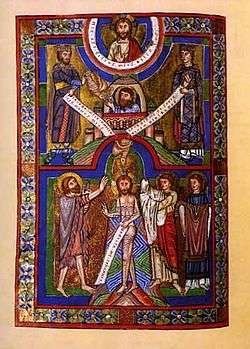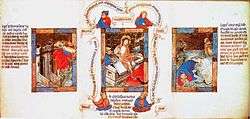Allegory in the Middle Ages
Allegory in the Middle Ages was a vital element in the synthesis of biblical and classical traditions into what would become recognizable as medieval culture. People of the Middle Ages consciously drew from the cultural legacies of the ancient world in shaping their institutions and ideas, and so allegory in medieval literature and medieval art was a prime mover for the synthesis and transformational continuity between the ancient world and the "new" Christian world.[1]

People of the Middle Ages did not see the same break between themselves and their classical predecessors that modern observers see; rather, they saw continuity with themselves and the ancient world, using allegory as a synthesizing agent that brings together a whole image.[1]
Four types of interpretation or allēgoria
For most medieval thinkers there were four categories of interpretation (or meaning) used in the Middle Ages, which had originated with the Bible commentators of the early Christian era.[2]
- The first is simply the literal interpretation of the events of the story for historical purposes with no underlying meaning.
- The second is called typological: it connects the events of the Old Testament with the New Testament; in particular drawing allegorical connections between the events of Christ's life with the stories of the Old Testament.
- The third is moral (or tropological), which is how one should act in the present, the "moral of the story".
- The fourth type of interpretation is anagogical, dealing with the future events of Christian history, heaven, hell, the last judgment; it deals with prophecies.
Thus the four types of interpretation (or meaning) deal with past events (literal), the connection of past events with the present (typology), present events (moral), and the future (anagogical).[2]
Dante describes interpreting through a "four-fold method" (or "allegory of the theologians") in his epistle to Can Grande della Scala. He says the "senses" of his work are not simple, but:
Rather, it may be called "polysemous", that is, of many senses. A first sense derives from the letters themselves, and a second from the things signified by the letters. We call the first sense "literal" sense, the second the "allegorical", or "moral" or "anagogical". To clarify this method of treatment, consider this verse: When Israel went out of Egypt, the house of Jacob from a barbarous people: Judea was made his sanctuary, Israel his dominion (Psalm 113). Now if we examine the letters alone, the exodus of the children of Israel from Egypt in the time of Moses is signified; in the allegory, our redemption accomplished through Christ; in the moral sense, the conversion of the soul from the grief and misery of sin to the state of grace; in the anagogical sense, the exodus of the holy soul from slavery of this corruption to the freedom of eternal glory.. they can all be called allegorical.
Old and New Testaments
Medieval allegory began as a Christian method for synthesizing the discrepancies between the Old Testament and the New Testament.[1] While both testaments were studied and seen as equally divinely inspired by God, the Old Testament contained discontinuities for Christians—for example the Jewish kosher laws.[1] The Old Testament was therefore seen in relation to how it would predict the events of the New Testament, in particular how the events of the Old Testament related to the events of Christ's life. The events of the Old Testament were seen as part of the story, with the events of Christ's life bringing these stories to a full conclusion. The technical name for seeing the New Testament in the Old is called typology.

One example of typology is the story of Jonah and the whale from the Old Testament.[1] Medieval allegorical interpretation of this story is that it prefigures Christ's burial, with the stomach of the whale as Christ's tomb. Jonah was eventually freed from the whale after three days, so did Christ rise from his tomb after three days. Thus, whenever one finds an allusion to Jonah in Medieval art or literature, it is usually an allegory for the burial and resurrection of Christ.
Another common typological allegory is with the four major Old testament prophets Isaiah, Jeremiah, Ezekiel, and Daniel. These four prophets prefigure the four Apostles Matthew, Mark, Luke, and John. There was no end to the number of analogies that commentators could find between stories of the Old Testament and the New.
There also existed a tradition in the Middle Ages of mythography—the allegorical interpretation of pagan myths.[2] Virgil's Aeneid and Ovid's Metamorphoses were standard textbooks throughout the Middle Ages, and each had a long tradition of allegorical interpretation.
- "An illustrative example can be found in Siena in a painting of Christ on the cross (Sano di Pietro's Crucifix, 15th c). At the top of the cross can be seen a bird pecking its own breast, blood pouring forth from the wound and feeding its waiting chicks below. This is the pelican whose "story" was told by the Roman naturalist Pliny the Elder. Thus by analogy to a "pagan" source, Christ feeds his own children with his own blood."
Mediaeval philosophers also saw allegory in the natural world, interpreting animals, plants, and even non-living things in books called bestiaries as symbols of Biblical figures and morals.[2] For example, one bestiary compares stags with people devoted to the Church, because (according to medieval zoology) they leave their pastures for other (heavenly) pastures, and when they come to broad rivers (sin) they form in line and each rests its head on the haunches of the next (supporting each other by example and good works), speeding across the waters together.[3]
History of allegory
Late Antiquity
The early allegorizing trait in the interpretation of the Hebrew Bible figures prominently in the massive oeuvre of a prominent Hellenized Jew of Alexandria, Philo Judaeus (c. 20 BC – c. 50 AD), whose allegorical reading of the Septuagint synthesized the traditional Jewish narratives with Platonism. Philo's allegorizing, in which he continued an earlier tradition, had little effect in later Jewish thought, in part because the Jewish culture of Alexandria dispersed by the fourth century.[4]
Christian writers such as Origen (184/185 – 253/254) took up the allegorized interpretations and began to read the Old Testament as a series of prefigurations of the New Testament,[4] in a time when rhetorical training was common, when the classics of mythology were still standard teaching texts, when the Greek and Roman pantheon of gods were still visible forms (if not always fully recognized by the more learned populace), and when the new religions such as Christianity adopted or rejected pagan elements by way of allegoresis (the study and interpretation of allegory).
Prudentius wrote the first surviving Christian purely allegorical freestanding work, Psychomachia ("Soul-War"), about AD 400.[1] The plot consists of the personified "good" virtues of Hope, Sobriety, Chastity, Humility, etc. fighting the personified "evil" vices of Pride, Wrath, Paganism, Avarice, etc. The personifications are women, because in Latin words for abstract concepts have feminine grammatical gender; an uninformed reader of the work might take the story literally as a tale of many angry women fighting one another, because Prudentius provides no context or explanation of the allegory.[1]
In this same period of the early 5th century three other authors of importance to the history of allegory emerged: Claudian, Macrobius and Martianus Capella. Little is known of these authors, even if they were "truly" Christian or not, but we do know they handed down the inclination to express learned material in allegorical form, mainly through personification, which later became a standard part of medieval schooling methods.[2]
Claudian's first work In Rufinum attacked the ruthless Rufinus and would become a model for the 12th century Anticlaudianus, a well known allegory for how to be an upstanding man. As well his Rape of Prosperpine served up a litany of mythological allegories, personifications, and cosmological allegories.[2]
Neoplatonist commentators[5] used allegory as a rhetorical, philosophical and religious devise in reading Ancient mythology, Homer,[6] and Plato.[5]
Macrobius wrote Commentary of the Dream of Scipio, providing the Middle Ages with the tradition of a favorite topic, the allegorical treatment of dreams.[2]
Lastly Martianus Capella wrote De nuptiis Philologiae et Mercurii ("Marriage of Philology and Mercury"), the title referring to the allegorical union of intelligent learning with the love of letters. It contained short treatises on the "seven liberal arts" (grammar, rhetoric, dialectic, geometry, arithmetic, astronomy, music) and thus became a standard textbook, greatly influencing educators and students throughout the Middle Ages.[2]
Boethius, perhaps the most influential author of Late Antiquity, first introduced readers of his work Consolation of Philosophy to the personified Lady Philosophy, the source of innumerable later personified figures (such as Lady Luck, Lady Fortune, etc.)[2]
Early Middle Ages
After Boethius there exists no known work of allegorical literature until the 12th century. Although allegorical thinking, elements and artwork abound during this period, it was not until the rise of the medieval university in the High Middle Ages that sustained allegorical literature appears again.[2]
High and Late Middle Ages
The earliest works were by Hugh of St Victor (Didascalicon, 1125), Bernard Silvestris (Cosmographia, 1147), and Alanus ab Insulis (Plaint of Nature, 1170, and Anticlaudianus) who pioneered the use of allegory (mainly personification) for abstract speculation on metaphysics and scientific questions.
The High and Late Middle Ages saw many allegorical works and techniques. There were four great works from this period.[2]
- The Four Great Medieval Allegories
- Le Roman de la Rose. A major allegorical work, it had many lasting influences on western literature, creating entire new genres and development of vernacular languages.
- The Divine Comedy. Ranked amongst the greatest medieval works, both allegorically and as a work of literature; was (and remains) hugely popular.
- Piers Plowman. An encyclopedic array of allegorical devices. Dream-vision; pilgrimage; personification; satire; typological story structure (the dreamer's progress mirrors the progress of biblical history from the Fall of Adam to Apocalypse).
- Pearl. A plot based on an anagogical allegory; a dreamer is introduced to heavenly Jerusalem. Focus on the meaning of death. A religious response to Consolation of Philosophy.
See also
Notes
- William R. Cook and Ronald B. Herzman (2001). Discovering the Middle Ages. The Teaching Company. ISBN 1-56585-701-1
- Stephen A. Barney (1989). "Allegory". Dictionary of the Middle Ages. vol-1. ISBN 0-684-16760-3
- The Book of Beasts, trans. T. H. White
- Norman F. Cantor, The Civilization of the Middle Ages, 1993:40.
- Florin Calian (2013).“Clarifications” of Obscurity: Conditions for Proclus’s Allegorical Reading of Plato’s Parmenides Obscurity in Medieval Texts (Krems: Institut für Realienkunde des Mittelalters und der frühen Neuzeit)
- Robert Lamberton (1989). Homer the Theologian: Neoplatonist Allegorical Reading and the Growth of the Epic Tradition (London: University of California Press).
References
- Stephen A. Barney (1989). "Allegory". Dictionary of the Middle Ages. vol-1. ISBN 0-684-16760-3
- William R. Cook and Ronald B. Herzman (2001). "Discovering the Middle Ages". The Teaching Company. ISBN 1-56585-701-1
- Sylvia Huot. Allegorical Play in the Old French Motet. Stanford, 1997.
- Conrad Rudolph, "The Architectural Metaphor in Western Medieval Artistic Culture: From the Cornerstone to The Mystic Ark," The Cambridge History of Religious Architecture, ed. Stephen Murray (2016)
- Conrad Rudolph, "Building the House of God: Architectural Metaphor and The Mystic Ark," Codex Aquilarensis: Revista de arte medieval (2016)